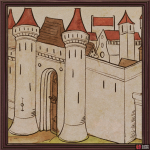Towns and Cities General
Text
In the Middle Ages, the merchant settlements and villages on major trade routes or around castles became the first towns. They were founded by specialised entrepreneurs, the so-called locators. Their task was to seek out settlers, prepare and apportion land and build a community.
The ruler set down the rights and obligations concerning the locators and settlers, e.g. the level and method of collecting taxes and benefits, town privilege rules of self-government (capital justice rights), trading (market rights and ‘one-mile’ selling rights) and brewing and handling beer (brewing rights). Newly established settlements and cities were often exempt from taxes for a certain period (lhůta) from which is derived the name of many Czech villages, Lhota).
Towns were of different types; royal, seigneurial, mining and dowry (which belonged to the Queen). Seigneurial towns were divided into ecclesiastical, secular (feudal) and those of the Royal Chamber.
Apart from the feudal settlements, towns were mostly rectangular in layout with streets perpendicular to a central square featuring a Town Hall, market and a church. Until the 14th century, the main streets and squares of the largest towns remained unpaved (uncobbled).
Waste was emptied directly into the street or thrown into waste pits dug around the houses, despite the fact that sanitation had existed since antiquity. Gutters of rammed earth carried sewage and rainwater alongside the streets and an unpleasant smell hovered over the towns. Settlements were surrounded by wooden palisades, and from the second half of the 13th century, walls, which had to have at least two gates.

 Sign up
Sign up
No Comments